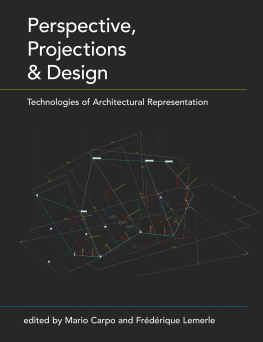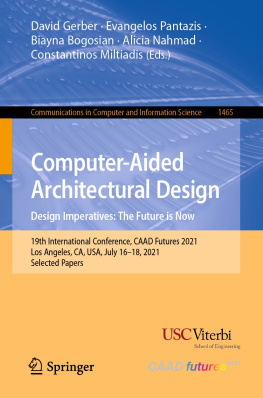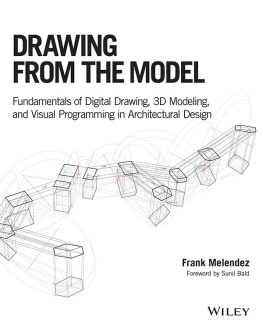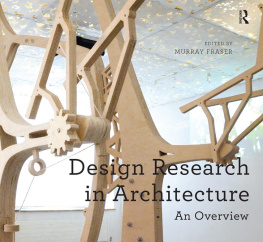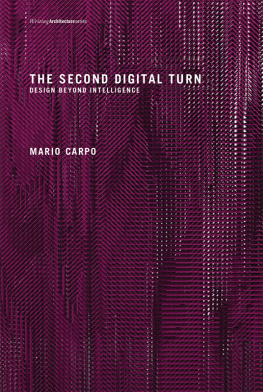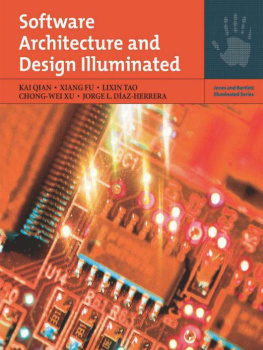Perspective, Projections and Design presents a selection of essays which discuss various aspects of image-making technologies, geometrical knowledge, and tools for architectural design, from the discovery of new formats for architectural drawing in the Renaissance to contemporary digital technologies for design and manufacturing.
Architectural drawings must represent three-dimensional objects in two dimensions. Their geometrical underpinnings have for centuries limited the boundaries of what architects can draw, measure and ultimately build. The essays in this book suggest a correlation between the early modern invention of architectural design and todays digital shift, as the latter reverses many of the architectural paradigms that were initiated in the Renaissance.
Mario Carpo is Associate Professor at the School of Architecture of Paris-La-Villette. Frdrique Lemerle is Director of Research at the Centre dtudes Suprieures de la Renaissance and University Franois-Rabelais in Tours, France.
Perspective, Projections and Design
Technologies of Architectural Representation
Edited by
Mario Carpo and Frdrique Lemerle
First published 2008
by Routledge
2 Park Square, Milton Park, Abingdon, Oxon OX14 4RN
Simultaneously published in the USA and Canada
by Routledge
711 Third Ave, New York, NY 10017
Routledge is an imprint of the Taylor & Francis Group, an informa business
2008 selection and editorial matter: Mario Carpo and Frdrique Lemerle; individual chapters: the contributors
Typeset in Avenir by Wearset Ltd, Boldon, Tyne and Wear
All rights reserved. No part of this book may be reprinted or reproduced or utilized in any form or by any electronic, mechanical, or other means, now known or hereafter invented, including photocopying and recording, or in any information storage or retrieval system, without permission in writing from the publishers. Every effort has been made to contact and acknowledge copyright owners, but the editors and publisher would be pleased to have any errors or omissions brought to their attention so that corrections may be published at a later printing.
British Library Cataloguing in Publication Data
A catalogue record for this book is available from the British Library
Library of Congress Cataloging-in-Publication Data
Perspective, projections, and design: technologies of architectural
representation/edited by Mario Carpo and Frdrique Lemerle.
p. cm.
Includes bibliographical references and index.
1. Perspective. 2. Architectural drawing. 3. Architectural design.
I. Carpo, Mario. II. Lemerle, Frdrique.
NA2710.P47 2007
720.284-dc22
2007003578
ISBN10: 0415402042 (hbk)
ISBN10: 0415402069 (pbk)
ISBN13: 9780415402040 (hbk)
ISBN13: 9780415402064 (pbk)
Contents
| Mario Carpo and Frdrique Lemerle |
| Pierre Gros |
| Bernard Cache |
| Martin Kemp and Antonio Criminisi |
| Mario Carpo |
| Jeanne Peiffer |
| Sabine Frommel |
| Pietro Roccasecca |
| Philippe Poti |
| Filippo Camerota |
| milie d'Orgeix |
| Alice Thomine-Berrada |
| Thierry Mandoul |
| Daniel Estvez and Grard Tin |
| Georges Teyssot |
BERNARD CACHE
Born in 1958, architect and theoretician. He created the concept of non-standard architecture in his book Earth Moves , published by MIT Press in 1995. This concept was given the name Objectile by Gilles Deleuze in his own book on Leibniz, The Fold and the Baroque . In 1996 Bernard Cache and his partner Patrick Beauc founded the company Objectile which develops technologies for non-standard architecture. Objectile now owns its own manufacturing unit and produces nonstandard components for architecture. Among various types of components Objectile created 3D decorative panels that were awarded the golden medal for innovation at Batimat 1997, the Building Industry Trade Fair in Paris. Objectile participated in many exhibitions of contemporary architecture, among which was the Non Standard Architecture exhibition held at the Centre Pompidou in Paris in 2003 to 2004. Bernard Cache has held teaching or research posts in several international universities such as the Escuela Superior de Arquitectura in Barcelona and the Berlage Institute in Rotterdam, and he pursues research on various theoretical topics, particularly on Vitruviuss De Architectura .
FILIPPO CAMEROTA
Is Deputy Vice-Director and Collection Manager of the Istituto e Museo di Storia della Scienza di Firenze, as well as a research associate at the Istituto Universitario di Architettura di Venezia (Department of Architectural History). His research concentrates on the history of scientific representation, with particular interest in Renaissance perspective and measuring instruments. His principal published works include studies on Giorgio Vasari the Younger, on Fabrizio Mordentes proportional compass, two digital editions of Galileos compass and two more works on perspective: La prospettiva del Rinascimento. Arte, architettura, scienza (Milan: Electa, 2006) and Leonardo da Vinci. Studio per lAdorazione dei Magi (Rome: Argos, 2006).
MARIO CARPO
An architectural historian and critic, is Associate Professor at the School of Architecture of Paris-La Villette (Paris). He has also held teaching and research posts in several universities in Europe, in the United States, and in Canada. His research and publications focus on the relationship between architectural theory, cultural history, and the history of media and information technology. His publications include the award-winning Architecture in the Age of Printing , published by the MIT Press in 2001 (also published in Italian and Spanish, with a French translation forthcoming); several monographs on Renaissance architectural theory; and a commentary of Leon Battista Albertis Descripto Urbis Romae (Geneva: Droz, 2000; forthcoming in English). His recent essays and articles are published in the Journal of the Society of Architectural Historians , Log , Grey Room , LArchitec ture daujourdhui , Arquitectura Viva , and AD/Architectural Design .
ANTONIO CRIMINISI
Is a researcher at Microsoft Research Ltd, Cambridge, UK. His research interests and scientific publications concentrate on machine vision, single-view metrology, vision applied to the history of art, object class recognition, and stereoscopic vision.
MILIE DORGEIX
Holds a doctorate in art history (Universit Laval, Quebec City, 1995). Her research focuses on the profession of the royal engineer in Europe and the colonies from the sixteenth to the eighteenth centuries, and particularly on the theory and practice of architectural drawing and military cartography. She has co-edited several publications including Les villes franaises du Nouveau Monde: des premiers fonda teurs aux ingnieurs du roi (Paris: Somogy, 1999); Atlas militaires manuscrits europens (Paris: Ministre de la Culture et de la communication, 2003); and Champagne-Ardenne: cinq sicles de cartographie (Paris: Somogy, 2005). She is currently in charge of the international commission for the documentation and conservation of the buildings and sites of the modern movement (Docomomo International) at the Cit de larchitecture et du patrimoine in Paris.

